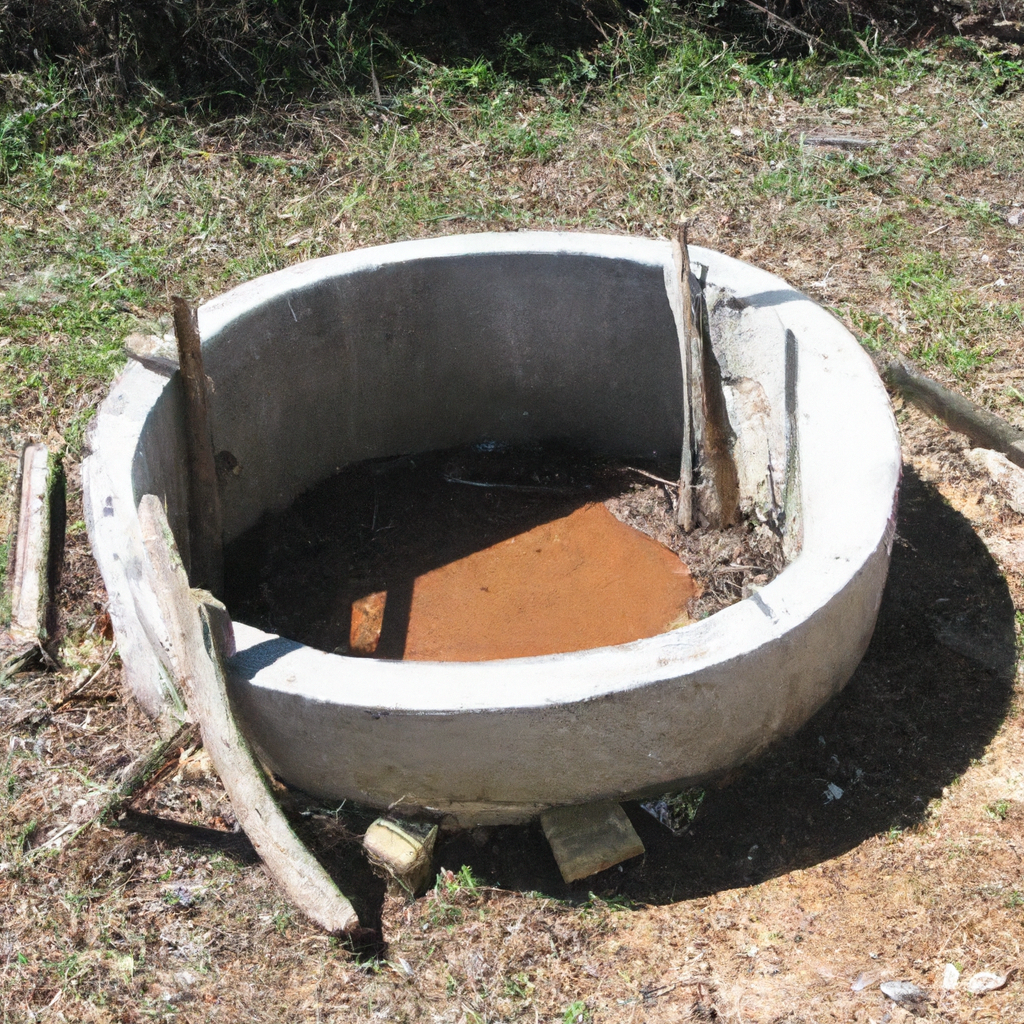So, you’re thinking about installing a 1000 gallon concrete septic tank? Well, you’ve come to the right place! In this article, we’ll walk you through the ins and outs of installing this essential piece of infrastructure. From understanding the purpose and benefits of a septic tank to the step-by-step installation process, we’ve got you covered. So grab a cup of coffee, sit back, and let’s get started on your journey to a properly functioning septic system!

Understanding Septic Tanks
A septic tank is an underground system used for the treatment and disposal of wastewater from a household or building that is not connected to a public sewer system. It serves as a primary treatment option for sewage and ensures the safe disposal of waste in an environmentally friendly manner. Septic tanks are essential in areas where there is no access to municipal sewer lines.
Concept of Septic Tanks
Septic tanks function by allowing the wastewater to separate into three layers. The solids settle to the bottom of the tank, forming sludge, while the lighter solids and particles float to the top, creating scum. The middle layer, known as effluent, contains liquid waste that can be discharged into the drain field for further treatment.
Difference Between Various Types of Septic Tanks
There are various types of septic tanks available, including plastic, fiberglass, and concrete. Each type has its own set of advantages and disadvantages. Plastic septic tanks are lightweight and easy to install, but they may be prone to cracking under certain conditions. Fiberglass tanks are durable and won’t corrode, but they can be more expensive. Concrete septic tanks are a popular choice due to their strength, longevity, and affordable cost.
Why Choose Concrete Septic Tanks
Concrete septic tanks offer numerous benefits that make them a preferred choice for many homeowners. They have a long lifespan, typically lasting up to 40 years with proper maintenance. Concrete tanks are resistant to corrosion and have a high tolerance for heavy loads, making them suitable for areas with high water tables or unstable soil conditions. Additionally, they provide excellent protection against leaks and intrusion from tree roots.
Determining the Size of the Septic Tank Needed
Choosing the appropriate size for your septic tank is crucial to ensure optimal functioning and prevent system overload. The size of the tank depends on various factors that should be considered during the planning stage.
Factors Influencing Septic Tank Size
The number of bedrooms in your house, the estimated water usage, the type of fixtures and appliances, and the soil conditions in your area are all factors that influence the septic tank size needed. It is essential to take into account the peak water usage, such as during family gatherings or when hosting guests.
Calculation of Tank Size Based on Household Size
A general guideline for determining the size of a septic tank is to estimate around 50-75 gallons per person per day. For a 1000 gallon septic tank, it is suitable for a household with up to four people. However, if your household has more than four people or includes additional water-intensive activities like gardening or laundry, a larger tank may be necessary.
Benefits of a 1000 Gallon Septic Tank
A 1000 gallon septic tank provides ample capacity for a standard-sized household and offers several advantages. It can handle the wastewater from daily activities without the risk of overflowing or causing system failure. A larger tank also allows for a longer retention time, improving the breakdown of solids and ensuring better treatment of the effluent. Additionally, a larger tank may require less frequent pumping, reducing maintenance costs in the long run.
Choosing the Right 1000 Gallon Concrete Septic Tank
Selecting the right concrete septic tank is crucial to ensure the longevity and efficiency of your system. Consider the following factors when making your decision:
Variety of Designs and Models
Concrete septic tanks are available in various designs and models, each offering unique features and advantages. Consider factors such as access points for maintenance and inspection, baffles for improved settling of solids, and options for effluent filters to enhance the treatment process.
Quality and Durability Assessment
It is essential to choose a concrete septic tank from a reputable manufacturer known for producing high-quality products. Evaluate the tank’s construction, thickness, and reinforcement to ensure it meets the necessary standards and regulations. A durable tank will withstand the test of time and provide reliable performance for years to come.
Cost of Purchase and Installation
Consider your budget when selecting a concrete septic tank. Compare prices from different suppliers and factor in additional costs such as delivery, installation, and any necessary permits. While cost is important, it should not be the sole determining factor. Investing in a reliable and durable septic tank will save you money in the long term by minimizing the need for repairs or premature replacement.
Preparing for Installation
Before installing your 1000 gallon concrete septic tank, proper preparation is essential to ensure a smooth process. The following steps will guide you through the necessary preparation tasks:
Required Tools and Materials
Gather the necessary tools and materials for the installation process. This may include a backhoe or excavator for digging the hole, leveling tools for ensuring proper alignment, a concrete collar for connecting the tank to the inlet and outlet pipes, and various hand tools for excavation and backfilling.
Choosing the Installation Site
Select a suitable location for your septic tank installation. It should meet local regulations and codes, be easily accessible for maintenance and pumping, and have sufficient distance from wells, water sources, and property boundaries. Avoid areas with high water tables or rocky soil that may hinder excavation or cause damage to the tank.
Creating a Project Plan
Develop a detailed project plan to ensure a systematic installation process. Consider factors such as the timeline, manpower required, and the sequence of tasks. This plan will help streamline the installation process and prevent any unnecessary delays or complications.

Excavation Process
Proper excavation is crucial for the successful installation of your 1000 gallon septic tank. Pay attention to the following aspects:
Determining the Dimensions of the Hole
Using the specifications provided by the manufacturer, calculate the necessary dimensions for the excavation hole. The length, width, and depth will vary based on the size and shape of the tank. Ensure that the hole is large enough to accommodate the tank with some additional space for easy access during maintenance.
Techniques for Digging the Hole
Use a backhoe, excavator, or other suitable equipment to dig the hole according to the calculated dimensions. Take care to maintain the proper slope for the tank and provide enough space for backfilling and compaction. Regularly check the dimensions throughout the excavation process to ensure accuracy.
Safety Precautions During Excavation
Excavation work can be hazardous, so it is crucial to prioritize safety. Ensure that the excavation site is properly marked and barricaded to prevent accidents or unauthorized access. Follow all safety guidelines, including wearing appropriate protective gear and addressing any potential hazards such as underground utilities or unstable soil conditions.
Installing the Septic Tank
Once the excavation is complete, it is time to install the concrete septic tank. Follow these steps for a successful installation:
Placement of the Tank into the Hole
Carefully lower the septic tank into the excavated hole using appropriate lifting equipment. Take care to align the tank properly according to the inlet and outlet pipes and ensure it is level. Ensure that the access points are easily accessible for future maintenance and inspection.
Balancing and Aligning the Tank
Ensure that the tank is properly balanced and aligned within the hole. Use leveling tools to ensure that the tank is level in all directions. Proper alignment will prevent stress on the tank and its connections, ensuring its longevity and optimal performance.
Techniques for Reducing Soil Settlement
To minimize soil settlement around the tank, use appropriate backfill materials and techniques. Strategically place compacted soil or gravel around the tank, avoiding excessive pressure that can cause deformation or damage. Follow the manufacturer’s recommendations for backfilling and compaction to ensure stability.

Connecting the Septic Tank
Properly connecting the septic tank to the house and creating the necessary inlet and outlet pipes is crucial for the efficient operation of the system. Follow these steps:
Connection to the House
Connect the main sewer line from your house to the septic tank inlet. Ensure that the connection is secure, leak-proof, and follows all local plumbing codes. Use appropriate materials, such as PVC pipes, that are resistant to corrosion and provide a seamless flow.
Installation of Inlet and Outlet Pipes
Install the inlet and outlet pipes according to the manufacturer’s guidelines and specifications. Ensure that the pipes are properly sealed and properly connected to the tank and the drain field. Utilize techniques such as using tee or elbow connections where necessary to ensure a smooth flow of effluent.
Sealing the Connections
Properly seal all connections to prevent leaks and ensure optimal functioning. Use appropriate sealants or gaskets as recommended by the manufacturer to create watertight connections. Regularly inspect the seals and connections for signs of wear or damage and address any issues promptly.
Backfilling and Compaction
After the tank is installed and connected, it is time to backfill the excavated area. Pay attention to the following considerations:
How to Backfill the Excavated Area
Use appropriate backfill materials, such as gravel or soil, to fill the excavated area around the septic tank. Gradually fill the space, compacting the material as you go to prevent settlement. Take care to avoid excessive pressure on the tank, as it may cause damage or compromise its integrity.
Techniques for Compacting the Backfill
Proper compaction of the backfill material is vital for the stability of the septic tank and the surrounding soil. Use appropriate compaction equipment, such as a compactor or roller, to achieve optimal density. Regularly check the compaction levels to ensure uniformity and address any uneven areas promptly.
Importance of Proper Backfilling and Compaction
Proper backfilling and compaction ensure that the tank remains stable and functional. It minimizes the risk of settlement, which can lead to a compromised system. Adequate backfilling also facilitates proper drainage and prevents any voids or air pockets that could negatively impact the tank’s performance.

Testing the Installation
Testing the septic tank installation is essential to ensure that it is functioning properly and to address any potential issues. Consider the following steps:
Testing for Leaks
Perform a thorough inspection of all connections, seals, and joints to check for any signs of leakage. This can be done by conducting a dye test or using a pressure gauge. Address any leaks promptly to prevent contamination of the surrounding soil or water sources.
Assessing the Level of the Tank
Check the level of the septic tank to ensure that it is properly balanced and aligned. This can be done using a level tool or by monitoring the water level inside the tank. Adjustments may be necessary to achieve the desired level and prevent stress or strain on the tank.
Initial Operation and Inspection
Once the installation is complete and the tank passes the necessary tests, you can begin using your septic system. Monitor its operation closely, ensuring that wastewater flows smoothly and there are no signs of backups or blockages. Conduct regular inspections and maintenance tasks to identify any early signs of potential issues.
Maintenance and Upkeep of a Concrete Septic Tank
Congratulations on successfully installing your 1000 gallon concrete septic tank! To ensure its longevity and proper functioning, it is crucial to follow regular maintenance tasks and address any potential issues promptly.
Routine Maintenance Tasks
Regular pumping of the septic tank is essential to remove accumulated solids and prevent system overload. This should be done every 3-5 years, depending on the usage and size of your household. Additionally, avoid disposing of non-biodegradable items or harmful chemicals down the drain, as they can cause clogs and damage to the system.
Potential Issues and Troubleshooting
Be vigilant for any signs of issues with your septic tank. These may include foul odors, slow drainage, gurgling sounds from drains, or unusually lush vegetation around the drain field. If you notice any of these signs, consult a professional septic tank service provider to address the problem promptly and prevent further damage.
Professional Inspection and Services
Regular professional inspections are highly recommended to ensure the optimal performance of your septic tank. Professionals can identify any potential issues, perform necessary maintenance tasks, and provide guidance on optimizing your system’s efficiency. They can also conduct regular pumping and ensure that all components of the septic system are in good working condition.
By understanding the concept of septic tanks, determining the right size, choosing a quality concrete tank, properly installing it, and following regular maintenance, you can guarantee a reliable and efficient septic system for years to come. Taking the time to plan and execute the installation properly will save you from unnecessary headaches and expenses in the future. Remember, a well-maintained septic tank is key to a healthy and sustainable wastewater management system.

